When was the last time you reviewed your vendor contracts closely? Many organizations assume their agreements are in order, but important risks are easily overlooked.
Overbilling, missing clauses, weak data protection terms, and non-compliance penalties can have serious repercussions if ignored.
Take this Reddit thread for example:
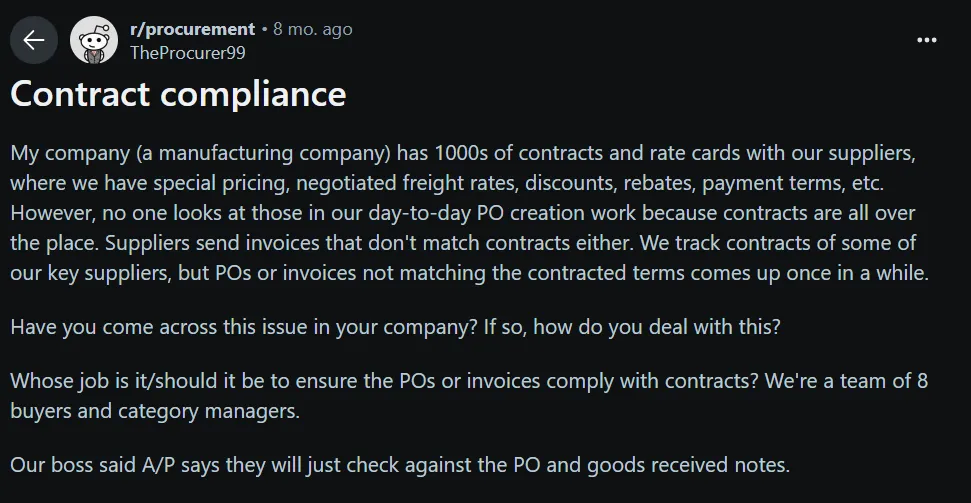
A contract compliance audit brings these issues to light and confirms that contracts are being followed.
According to The Business Research Company's 2025 Contract Management Software Global Market Report, the contract management software market experienced rapid 15.4% growth in 2025, driven primarily by organizations' focus on contract compliance and risk management.
The surge demonstrates how contract compliance audits are becoming essential for managing third-party relationships as regulatory requirements and business risks continue to expand.
In this guide, you’ll learn:
- A simple, step-by-step approach to performing a contract compliance audit.
- The most common risks and red flags that audits reveal.
- Practical best practices that make audits smoother and more effective.
- How to utilize Signeasy to streamline the process and strengthen outcomes.
Before we walk through the steps, let’s start with the basics.
What is a contract compliance audit?
A contract compliance audit is a structured review of vendor or partner agreements to verify whether all terms and obligations are being met.
While general compliance reviews examine company-wide policies and regulatory standards broadly, contract compliance audits focus specifically on the detailed terms and conditions of individual agreements.
The audit examines three main areas:
- Performance obligations: Checking that vendors or service providers deliver goods, services, and timelines as outlined in the agreement.
- Legal obligations: Confirming that required contractual clauses (such as data protection, liability, or confidentiality terms) are included, and where in scope, ensuring they align with applicable laws and regulations.
- Financial obligations: Reviewing pricing, billing, and payment terms to identify overbilling, missed discounts, or unapproved charges.
Through examination of these areas, a contract compliance audit provides assurance that contracts are being carried out as intended, while also identifying risks or inefficiencies that can otherwise remain hidden.
The scope and timing of audits depend on what prompts them. The main categories are discussed below.
Types of contract compliance audits
Contract compliance audits can be classified into different types based on their timing, triggers, and who conducts them. Knowing the difference between these types helps in selecting the right approach for your organization’s use case.
Contract compliance audits fall into four main categories, each defined by timing, trigger, or the party responsible for execution. Selecting the right type depends on the organization’s objectives and circumstances.
Proactive audits are scheduled ahead of time to detect and resolve issues before they interfere with operations. In the education sector, for example, institutions routinely audit textbook suppliers prior to the start of a semester to confirm that delivery schedules and quality standards will be met. This early review helps prevent disruptions in classrooms.
Reactive audits are initiated in response to specific problems. In construction, if a subcontractor fails a safety inspection, the audit examines the underlying contracts to determine whether safety protocols were clearly defined and whether obligations were carried out as agreed.
Internal audits are conducted by an organization’s own compliance or procurement teams. Healthcare providers often use this approach to verify that medical equipment suppliers adhere to contractual maintenance schedules and that service commitments align with patient care requirements.
External audits involve independent third parties who bring impartiality to the review process. In the travel and hospitality industry, these audits are often a compulsory annual practice, but they may also be conducted after service disruptions to evaluate whether booking platform vendors upheld their contractual service level agreements and performance standards.
Understanding these categories equips organizations to choose the audit type that best addresses their contractual risks and operational priorities.
How to perform a contract compliance audit (step-by-step process)
Most contract compliance issues stem from poor visibility and reactive management. A systematic audit methodology shifts organizations from reactive to proactive risk management.
The four-phase process below uses banking and financial services contracts to demonstrate how each step tackles specific compliance challenges.
Step 1: Pre-audit planning and setup
Strong foundational planning keeps audits focused and comprehensive across all critical areas.
1a. Define audit scope and objectives
Start by identifying which contracts need to be audited and what you aim to accomplish. For banking and financial services contracts, audits typically focus on verifying whether service providers are meeting transaction processing requirements.
They also assess compliance with regulatory reporting deadlines and adherence to agreed-upon service levels.
1b. Assemble an audit team
Bring together the right people for the job. A financial institution may need compliance officers, procurement specialists, and legal advisors. Signeasy’s admin controls let you invite users, assign roles and permissions, and manage document access across teams.
These controls make it easier to track in-flight contracts by showing who needs to sign, review, or approve, and where each document stands.
1c. Gather necessary contracts and documentation
Collect all contracts, agreements, and relevant documentation.
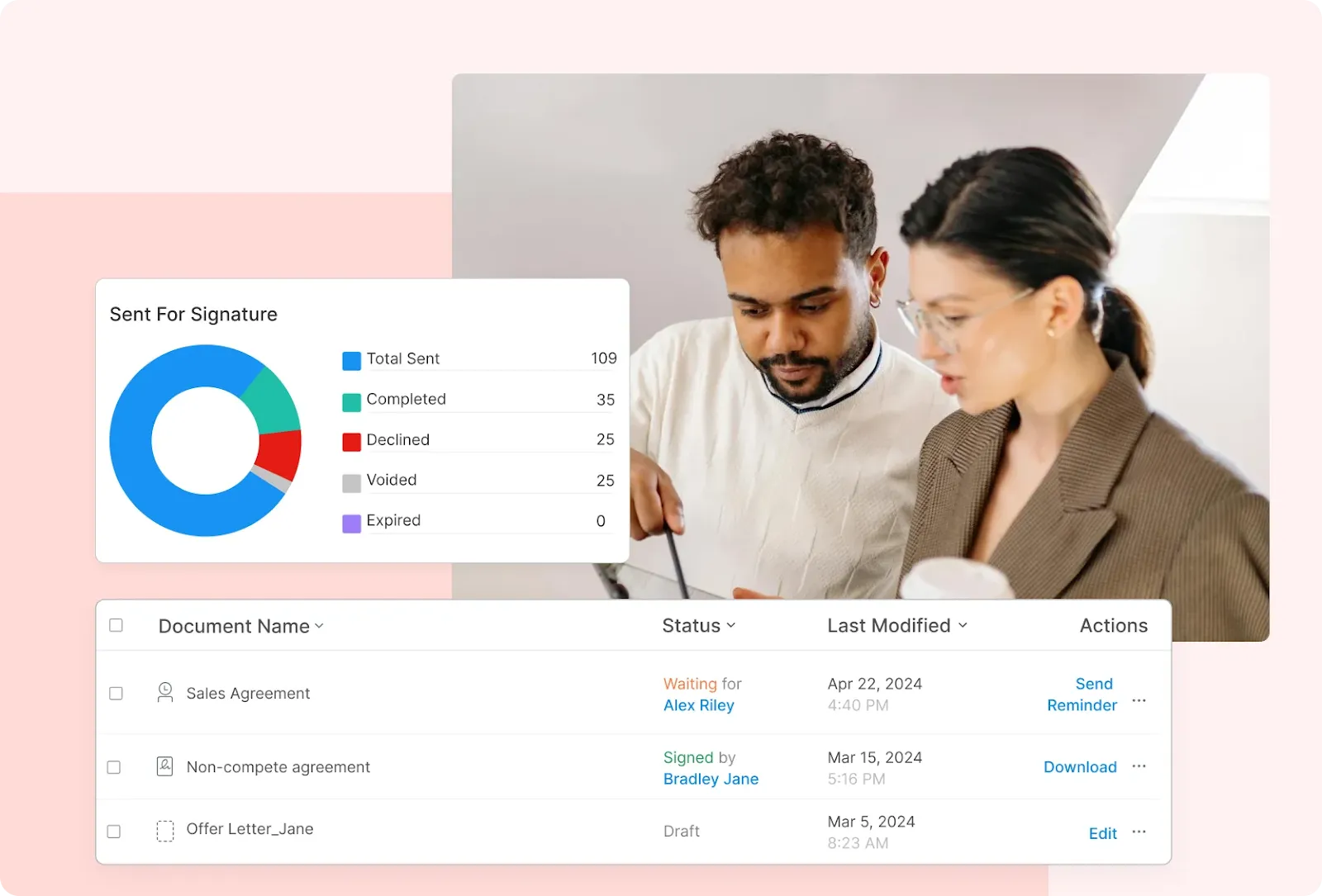
In banking and finance, this can include payment processing agreements, loan servicing contracts, and regulatory compliance documentation. Having everything in one place will streamline the audit process.
Step 2: Contract discovery and risk assessment
After you’ve set up your audit team and gathered your documentation, it’s time to dig deep into the contracts and assess any potential risks.
2a. Create a comprehensive contract inventory
Use a secure, centralized storage system like Signeasy's contract repository to keep track of all contracts. No contracts get overlooked, and they remain easily accessible for review.
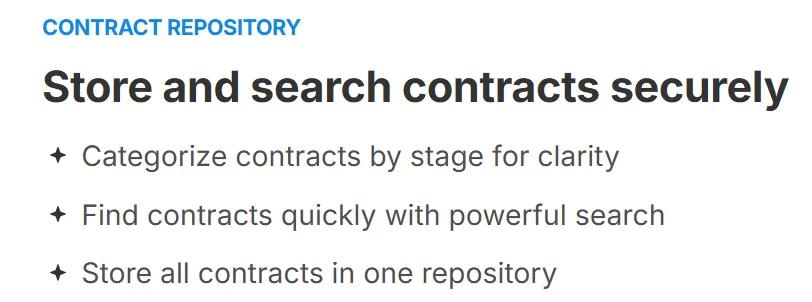
2b. Prioritize contracts based on risk and value
In banking and finance, prioritize contracts based on criticality. For example, contracts involving payment processing systems or regulatory reporting services may carry a higher risk than those for non-critical administrative services.
Use Signeasy’s status filtering (e.g., Signed, Waiting, Voided, Expired) to sort contracts based on their current status, helping you focus on the most important ones first.
2c. Have sufficient access to data sources for monitoring
The NAVEX report (cited earlier) states that 69% of organizations have sufficient access to data sources for monitoring, which is important for performing effective audits. In banking, having access to data on vendor performance, transaction volumes, and service level metrics is essential for verifying contract adherence.
2d. Utilize Signeasy's powerful search tools to locate documents quickly
With Signeasy's powerful search and filters tools, you can locate documents quickly across your workspace. Large banking audits often involve multiple agreements and documents to review, making search functionality invaluable.
For clause work, use Signeasy AI to extract and review key terms (e.g., service levels, liability) so auditors can jump to the right sections fast.
Step 3: Compliance review and analysis
At this stage, you’ll assess whether the terms of the contracts are being followed, focusing on performance, legal, and financial obligations.
3a. Verify performance obligations
Check that the vendor is delivering the goods or services as agreed. For example, confirm that the payment processing vendor is meeting the transaction volume requirements and response times outlined in the contract, such as 99.9% uptime or sub-second processing speeds.
3b. Check legal and regulatory compliance
In banking, contracts often require vendors to meet financial-sector obligations (e.g., PCI DSS controls for card data, SOX-aligned internal controls, AML requirements) and data-protection laws such as GDPR when applicable.
Industry-specific rules like HIPAA or 21 CFR Part 11 apply primarily to healthcare/life sciences workflows and should be included only if vendors handle PHI or regulated electronic records.
Use Signeasy to protect documents and maintain evidence — with audit trails, role-based access, and compliance options such as HIPAA and 21 CFR Part 11-ready controls — while your audit validates vendor adherence to those obligations.
3c. Review financial terms and payment schedules
For the financial aspect, verify that the pricing, billing, and payment terms are being followed. In banking contracts, this can involve reviewing transaction fees, service level credits, or confirming that any penalties for missed SLA targets are applied correctly.
3d. Track document activity
Signeasy’s audit trails and dashboards capture status and activity (e.g., sent, viewed, signed) for traceability. The feature helps determine whether relevant stakeholders have signed off on key deliverables in the banking service contract, and confirms that the document workflow is progressing smoothly.
3e. Document findings systematically
Record all findings, including any issues or discrepancies identified during the review. Documentation forms the basis of your audit report and provides a clear record of compliance status.
Step 4: Reporting and action planning
After completing the audit review, it’s time to generate a comprehensive report and plan next steps for addressing any gaps in compliance.
4a. Generate visual insights for contract progress and team efficiency metrics
Utilize Signeasy’s reports and dashboard to visualize contract progress and team efficiency (e.g., completion rate, average time to complete, status distribution).
These insights help identify workflow delays and bottlenecks so banking operations maintain consistent document turnaround.
4b. Create detailed audit report
Prepare a detailed audit report outlining findings, then generate and download Signeasy usage/status reports to share with stakeholders and inform decisions.
4c. Set up real-time email notifications for document status updates
Stay updated with real-time email notifications and automated reminders for status changes (viewed, signed, pending too long), so audit-relevant contracts don’t stall.
4d. Prioritize compliance gaps
Identify the most critical compliance gaps revealed during the audit. For instance, if the vendor is failing to meet transaction processing volumes, this would need to be addressed immediately to avoid service disruptions.
4e. Develop remediation timeline
Create a remediation timeline for addressing compliance issues. Options may involve renegotiating terms with the vendor, implementing corrective actions, or even terminating a contract if necessary.
4f. Establish follow-up procedures
Lastly, establish a clear follow-up process to monitor contract compliance over time. Consider setting up periodic checks or assigning someone to verify that any changes are implemented effectively.
With the process outlined, it’s worth stepping back to see why these audits are important to your business.
Why contract compliance auditing is essential for your business
Contract compliance audits are essential for protecting your business, managing risks, and maintaining financial and operational efficiency. Here's why they should be a priority:
- Risk mitigation and legal protection
A contract compliance audit helps identify issues like overbilling or non-compliance with legal terms, preventing costly disputes and penalties. For example, an audit can reveal a payment processor not meeting agreed-upon transaction volume requirements, potentially causing service disruptions and contract penalties.
Contract compliance audits validate adherence to contractual obligations and surface missing or weak clauses that expose the business to legal and regulatory risk.
Where in scope — and in consultation with legal or compliance teams — auditors can also confirm that required provisions align with applicable laws and industry standards, helping organizations avoid fines, breach claims, and downstream disputes.
- Financial benefits and cost optimization
Contract audits identify where you’re overpaying or missing entitled discounts and credits. For example, auditors may find charges for undelivered services, rate-card deviations, duplicate invoices, or unclaimed service credits — issues that enable recoveries and lower ongoing spend.
Regular reviews also verify that vendors honor financial obligations such as tiered discounts, volume rebates, and SLA credits, reducing cash leakage and tightening AP controls. When financial terms are followed and evidenced, audits improve the accuracy of accruals and budget forecasts and ensure credits are recognized in the correct period.
- Operational efficiency improvements
Audits identify inefficiencies in how contracts are being managed, such as missed deadlines or unmet performance standards. Addressing these issues through remediation and process changes can lead to smoother workflows and more reliable vendor performance.
Regular audits increase transparency and accountability, helping both parties meet their obligations and can strengthen long-term partnerships. A clear understanding of expectations benefits both sides.
Contract compliance audits help verify whether vendors are meeting the performance standards outlined in the contract, supporting consistency and improving the quality of deliverables.
Achieving these outcomes consistently requires a structured approach to contract compliance auditing, with defined remediation actions and follow-up monitoring.
Best practices for effective contract compliance auditing
Success in contract compliance auditing comes down to these fundamentals:
- Building your audit framework
An audit contract compliance is only as strong as the framework supporting it. Establishing clear audit criteria that define exactly what you will measure helps create a solid foundation.
Define delivery timelines, service levels, regulatory clauses, and payment terms as your key metrics. Setting these benchmarks upfront maintains consistency across audits and prevents scope creep.
From there, create standardized checklists that guide auditors through each stage. A repeatable checklist approach not only saves time but also improves accuracy, since the same criteria are applied to every contract.
Finally, define communication protocols so findings are shared quickly with stakeholders. Scheduled updates or structured reports help maintain clarity in communication and avoid delays in addressing compliance gaps.
- Utilizing technology for better results
Manual contract reviews are no longer sufficient in complex business environments. Technology brings structure and speed to the process while reducing the risk of oversight.
A contract management platform like Signeasy allows organizations to maintain centralized storage, with contracts pending, completed, voided, or expired. Complete visibility reduces the chance of contracts going unmonitored or expiring without notice; built-in reminders and calendar sync help teams stay ahead of renewals.
Security is equally important. Implement two-factor authentication and role-based access controls; assign admin, member, or viewer permissions and restrict access via Teamspace so legal, finance, and operations only see what they need.
Modern auditing benefits from native integrations with Google Workspace, SharePoint, Outlook, and HubSpot, allowing contracts to flow between core business systems and cutting manual uploads.
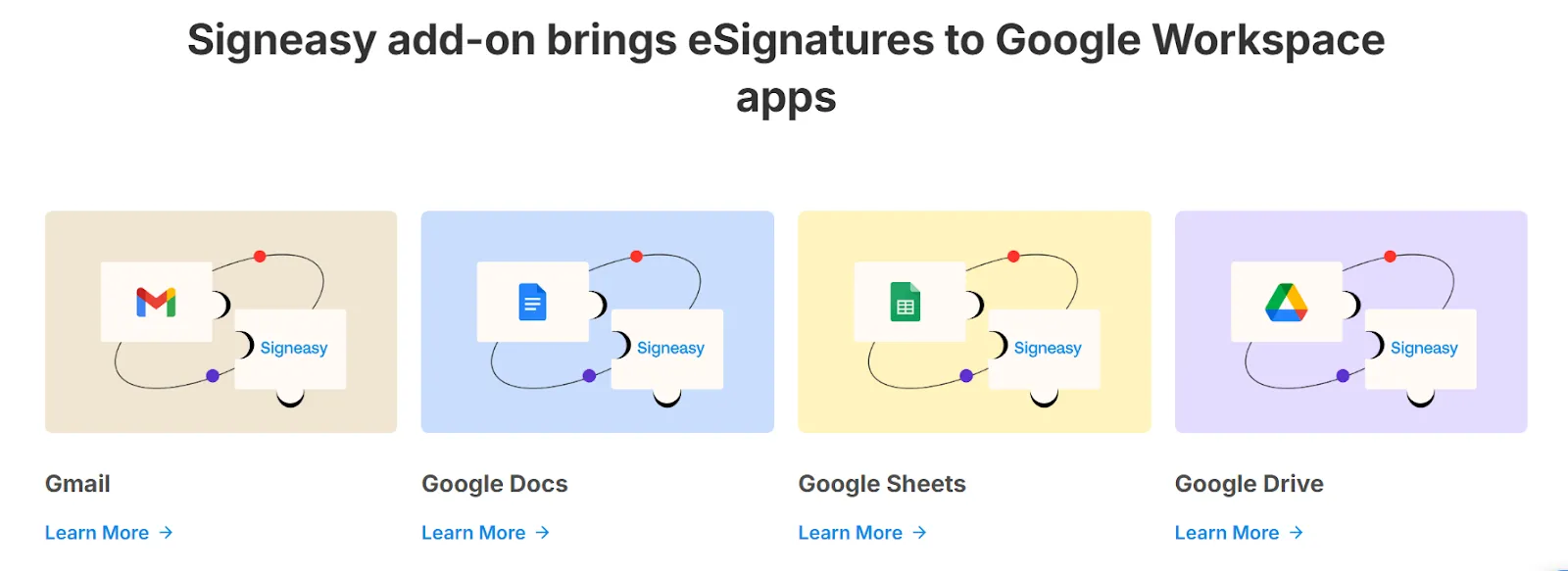
These integrations make audits faster and help teams work within their existing tools.
Perhaps most valuable is automated compliance monitoring. Instead of waiting until renewal, use reminders and status alerts to track upcoming obligations and unsigned agreements.
With Signeasy AI, you can extract clauses, summarize terms, and surface key fields for faster review, turning compliance into an ongoing safeguard rather than a reactive exercise.
- Maintaining audit security and confidentiality
Trust is central to contract compliance auditing. Every audit involves reviewing sensitive financial, legal, and operational details that should be protected.
Signeasy provides enterprise-grade protections and comprehensive audit trails, meaning every action gets recorded and secured. Document views, edits, and signatures are all tracked automatically.
Strong team permission management is also critical. Limiting access based on responsibilities strengthens confidentiality and reduces distractions, as team members only see the contracts relevant to them.
Finally, establish document retention policies to determine how long records are stored and when they should be archived or deleted. Clear retention rules not only support regulatory compliance but also keep your contract repository organized and audit-ready.
Following the setup of retention policies, let’s examine challenges that often disrupt contract audits and their solutions.
Common contract compliance audit challenges and solutions
The report cited earlier also found that 64% of organizations plan to expand cybersecurity training within the next 2–3 years. Yet many still face recurring hurdles when running contract compliance audits.
Below are some of the most common challenges organizations face — and practical solutions to address them.
To know if your contract audit efforts are paying off, you need clear measures of success.
Measuring contract compliance audit success
Contract compliance auditing is only valuable if results can be measured. Tracking the right metrics shows whether your compliance program is working and where it can improve.
Key performance indicators
To determine if your program is working, you need to track the right metrics.
- Compliance rate improvements: Measure the percentage of contracts meeting their obligations compared to the last audit cycle. An upward trend signals that corrective actions are working.
For example, if 75% of contracts met delivery deadlines in Q1 and 85% met them in Q2, your compliance rate improved by 10 percentage points (a ~13.3% relative increase).
- Cost reduction achievements: Track recovered overpayments, realized discounts, or avoided penalties. These tangible savings demonstrate the financial impact of audits.
For instance, discovering a vendor charged for services not delivered could recover $15,000 in overpayments.
- Risk mitigation effectiveness: Record how many potential risks (missing clauses, vendor delays, or regulatory gaps) were identified and resolved before they escalated. The fewer repeat issues found across cycles, the stronger your compliance maturity.
For example, finding and fixing 12 contracts missing data protection clauses reduces the risk of GDPR violations before they occur (in consultation with legal/compliance as needed).
Continuous improvement strategies
An effective compliance audit program needs a plan for continuous improvement. It's not enough to simply identify issues; you should also have a strategy to address them and monitor progress over time.
- Post-audit action implementation: A successful audit doesn’t end with the report. Document follow-up tasks, assign owners in your project tracker, and verify closures against Signeasy’s audit trails, reminders, and status reports.
- Regular audit schedule optimization: Instead of treating audits as annual events, establish a cadence based on contract criticality — quarterly for high-value vendors, annually for lower-risk agreements.
- Performance monitoring systems: Use ongoing monitoring to track vendor adherence between audits. Creating a feedback loop highlights issues early, so audits confirm improvements rather than just reveal problems.
These strategies help build a strong audit program, and Signeasy provides tools to simplify key parts of the workflow — centralized access, reminders/alerts, dashboards, and audit trails.
How Signeasy supports contract compliance audits
Contract compliance audits reduce risk, strengthen regulatory adherence, and help organizations recover costs that might otherwise be lost. While the process is important, it can also be complex.
But Signeasy simplifies the key parts of the contract compliance auditing process.
- Centralized workspace: Store contracts securely in one place (Teamspace and dashboard), with search and filters for fast retrieval. Use Signeasy AI to extract clauses, summarize terms, and surface key fields for review. Centralized visibility reduces the chance of overlooking in-scope agreements.
- Status filtering and views: Auditors can quickly see which contracts are pending, completed, voided, or expired, which simplifies prioritization and helps track progress at a glance.
- Audit-ready security and compliance: Enterprise-grade protections with SOC 2, GDPR, HIPAA, ESIGN/UETA, and eIDAS support, plus comprehensive audit trails for traceability of actions. Every document action is logged with a complete audit trail.
- Reports and dashboard: Visual insights show status distribution, completion rate, and average completion time, and reports can be downloaded/exported for stakeholders, reducing reporting effort.
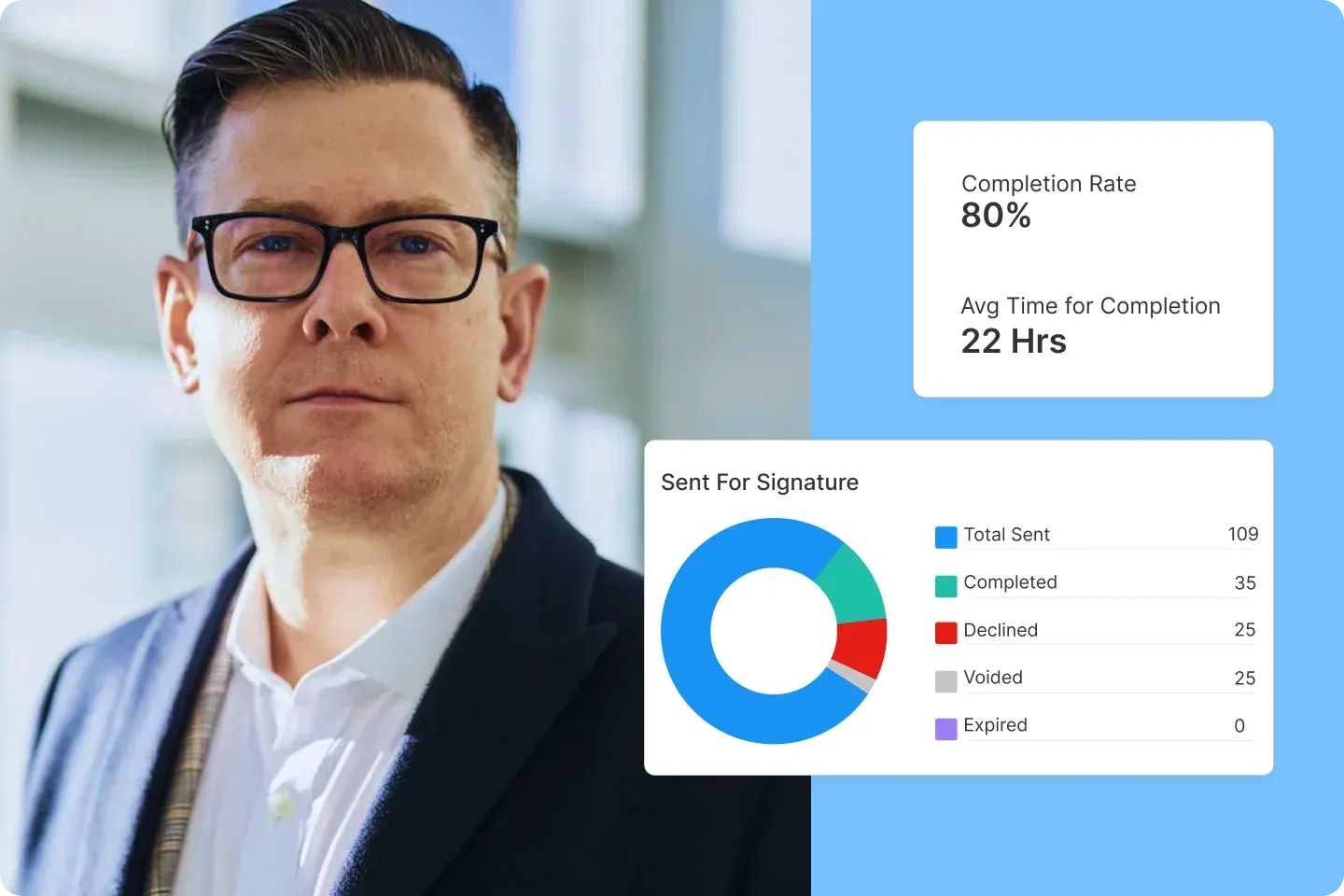
- Email notifications: Automated email alerts and reminders for pending or overdue signatures keep audits moving and prevent obligations from being overlooked.
These features transform contract compliance audits from a manual, resource-heavy task into a streamlined, secure process that provides real value to the business. See how much easier contract audits can be. Start your Signeasy trial today.



.webp)






-min.png)
